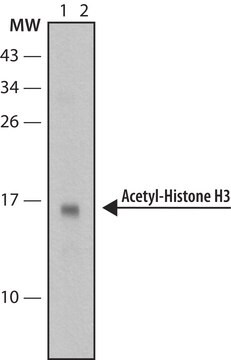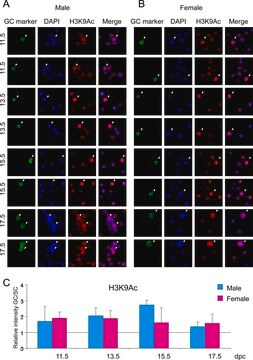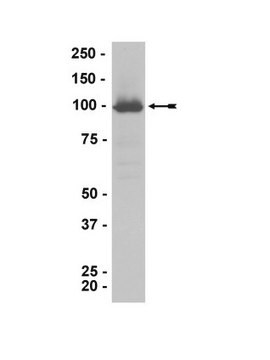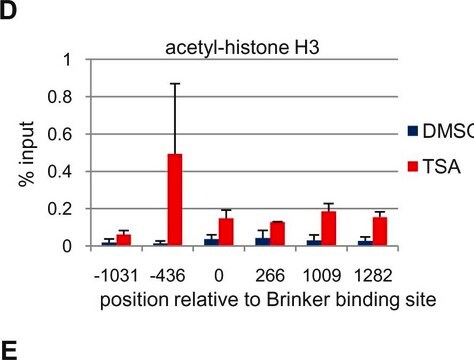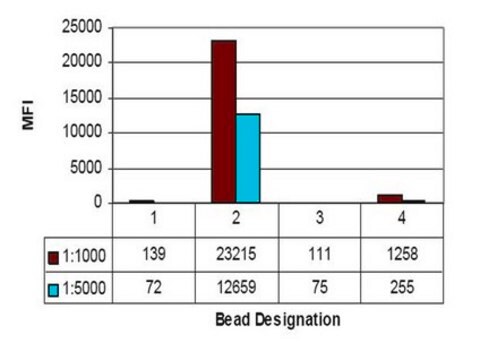07-355
Anti-acetyl-Histone H3 (Lys23) Antibody
serum, Upstate®
Synonym(s):
H3K23Ac, Histone H3 (acetyl K23)
About This Item
Recommended Products
biological source
rabbit
Quality Level
antibody form
serum
antibody product type
primary antibodies
clone
polyclonal
species reactivity
Saccharomyces cerevisiae, human, vertebrates
manufacturer/tradename
Upstate®
technique(s)
ChIP: suitable
dot blot: suitable
western blot: suitable
NCBI accession no.
UniProt accession no.
shipped in
wet ice
target post-translational modification
acetylation (Lys23)
Gene Information
human ... H3C1(8350)
General description
The N-terminal tail of histone H3 protrudes from the globular nucleosome core and can undergo several different types of epigenetic modifications that influence cellular processes. These modifications include the covalent attachment of methyl or acetyl groups to lysine and arginine amino acids and the phosphorylation of serine or threonine.
Specificity
Immunogen
Application
Representative lot data.
Sonicated chromatin prepared from HeLa cells (1 X 10E6 cell equivalents per IP) were subjected to chromatin immunoprecipitation using 2 µL of either normal rabbit serum or 2 µL Anti-acetyl-Histone H3 (Lys23)and the Magna ChIP A Kit (Cat. # 17-610). Successful immunoprecipitation of acetyl-Histone H3 (Lys23) associated DNA fragments were verified by qPCR using Control Primers specific for the human GAPDH promoter region as a positive locus, and MyoD primers as a negative locus. Data is presented as percent input of each IP sample relative to input chromatin for each amplicon and ChIP sample as indicated.
Please refer to the EZ-Magna ChIP A (Cat. # 17-408) or EZ-ChIP (Cat. # 17-371) protocol for experimental details.
Western Blot Analysis:
Representative lot data.
Acid extracts from sodium butyrate treated HeLa cells (Lane 1, Catalog # 17-305) and recombinant Histone H3 (Lane 2, Catalog # 14-494) were probed with Anti-acetyl-Histone H3 (Lys23) (1:100,000 dilution).
Arrow indicates acetyl histone H3 (~17 kDa)
Dot Blot:
Representative lot data.
40 ng and 4ng amounts of histone peptides with various modifications (see table 1) were transferred to PVDF membrane and probed with Anti-Acetyl-Histone H3 (Lys23) antibody (1:2000 dilution). Proteins were visualized using a goat anti-rabbit IgG conjugated to HRP and a chemiluminescence detection system. Image from a 60 second exposure is shown.
Epigenetics & Nuclear Function
Histones
Quality
Target description
Physical form
Storage and Stability
Analysis Note
Acid extracts from sodium butyrate treated HeLa cells
Legal Information
Disclaimer
Not finding the right product?
Try our Product Selector Tool.
Storage Class Code
10 - Combustible liquids
WGK
WGK 1
Certificates of Analysis (COA)
Search for Certificates of Analysis (COA) by entering the products Lot/Batch Number. Lot and Batch Numbers can be found on a product’s label following the words ‘Lot’ or ‘Batch’.
Already Own This Product?
Find documentation for the products that you have recently purchased in the Document Library.
Our team of scientists has experience in all areas of research including Life Science, Material Science, Chemical Synthesis, Chromatography, Analytical and many others.
Contact Technical Service

